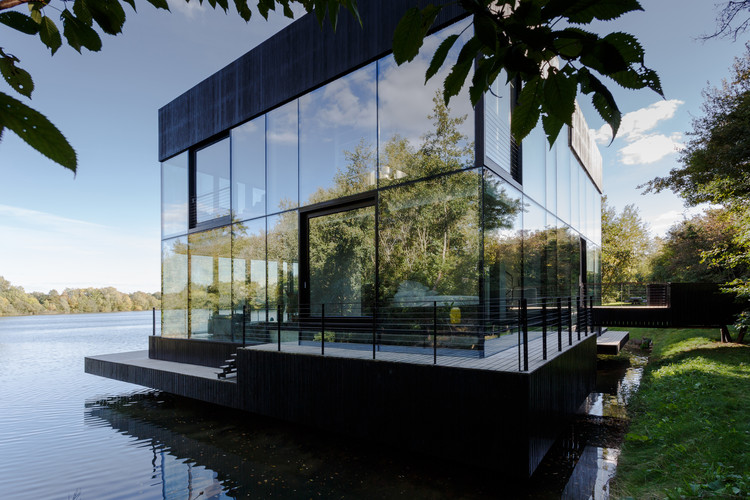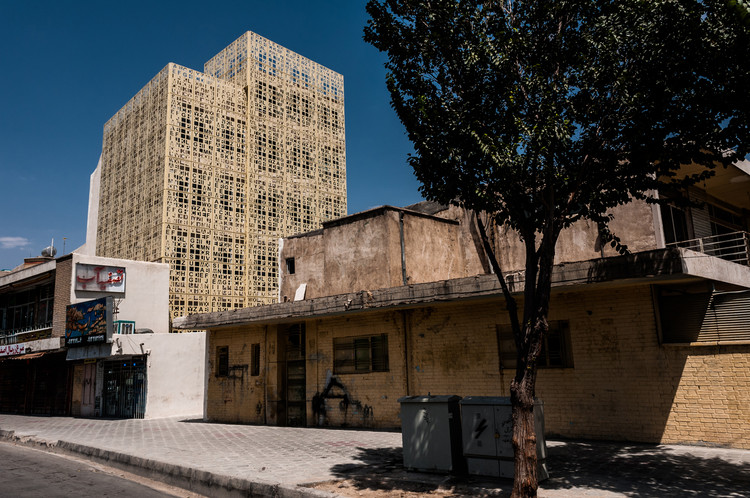Soil Centre Copenhagen Christensen - Co
2014-01-27 01:00
Between the sky and the ocean
在Resund的边缘,在自由港和集装箱码头后面,天空与海洋相遇,那里是哥本哈根市政府新的土壤处理中心-哥本哈根土壤中心。就在这里,哥本哈根周围的建筑工程和地铁建筑工地挖出了数百万立方米的土壤,为哥本哈根的新城区诺德哈文创造了新的土地。
On the edge of Øresund, where the sky meets he ocean behind the Freeport and the Container Terminal lies Copenhagen Municipality's new soil treatment centre, Soil Centre Copenhagen. It is here millions of cubic metres of dug up soil from construction projects and metro building sites around Copenhagen create new ground for Copenhagen´s new urban area Nordhavn.
该中心的工作人员分析和处理受污染的土壤,确保以无害环境的方式使用。诺德哈文的景观是平坦的,形成了迷人和不断变化的风景,巨大的土壤堆和巨大的挖掘。最重要的是,它看起来像一个粗糙的月球景观,遗留下来的建筑材料和生锈的金属部件。在哥本哈根土壤中心的西北部,景色郁郁葱葱,小山碧绿,灌木丛丛生,池塘和湖泊四面环绕着灌木。一个野生的自然地点,充满了来自鸟类,天鹅和喵的海鸥的声音。它也是在这里被保护的欧洲绿蟾蜍,为自己创造了一个新的家园。这导致了一项决定,即始终保持该地区的原样。有了这个非常独特的背景,哥本哈根土壤中心以其独特的形状和生锈的红色立面从景观中生长出来。这座建筑在广阔的地平线上有着独特的轮廓,同时也是景观的一个整体,也是一个明显的人造物体。
The centre employees analyse and handle the contaminated soil, making sure that it is used in an environmentally safe manner. The landscape at Nordhavn is flat and makes for a fascinating and ever changing scenery, giant piles of soil and huge excavations. More than anything, it looks like a rough lunar landscape with left-over building materials and rusty metal parts. To the Northwest of Soil Centre Copenhagen the landscape is contrastingly lush with little green hills, shrubbery and little ponds and lakes fringed with rushes. A wild nature site filled with sounds from birds, swans and mewing seagulls. It is also here the protected European Green Toad, has made a new home for itself. This has led to a decision to always preserve the area the way it is. With this very unique context Soil Centre Copenhagen grows out of the landscape with its characteristic shape and rusty red facades. The building has a distinctive silhouette against the vast horizon, and the building is simultaneously an integrated part of the landscape and an obviously man-made object.
Completely different spaces in one sculptural form
这座雕塑建筑在重型机械和自然保护区之间形成了一个保护边界,其曲折的形状创造了面向土壤到达区或自然地点的空间。外立面是由锈蚀的耐候钢制成的弹性金属。在屋顶上,高高的草地,随着时间的推移,即使是小小的灌木丛和树木也会长出来。从这个意义上说,这座建筑弥补了它所占用的一部分景观,并将有助于保护该地区的自然生物多样性。这种耐候钢由一层红色的锈层保护,在视觉上将它与该地区和宏伟的建筑环境轮廓连接起来。除了美丽的红色外,它还提供了一个坚固的表面,能够在这个严酷的环境中抵御灰尘和污垢。
The sculptural building makes for a protecting boundary between areas trafficked by heavy machinery and the protected nature site, and with its zigzagging shape the building creates spaces that face either towards the soil arrival area or the nature site. The facades are clad in stretch metal made from rusty weathering steel. On the roof tall grass and, in time, even smallish bushes and trees will grow. In this sense the building makes up for the piece of the landscape it has occupied, and will help preserve the natural biodiversity of the area. The weathering steel is protected by a red layer of rust, visually connecting it to the area and the ambitious environmental profile of the building. It offers, besides the beautiful red colour, a robust surface that can withstand the dust and dirt in this harsh environment.
中心由一系列非常不同的空间和功能组成,建筑的形状源于对高度和空间的特殊需要。大楼内设有办公室、实验室、更衣室、两个大型车间、车库和储藏室。在大楼的中心,办公区域变成了一片宁静的绿洲,透过精心布置的窗户俯瞰周围的环境,每一扇窗户都提供美丽的景致或雷圣德水域的景致。同时,立面窗户的放置优化了自然光的使用,使光线的特性和质量成为建筑叙事的一个整体部分。
The centre consists of a series of very different spaces and functions, and the shape of the building arose from the particular need for height and spaciousness. The building consists of an office section for employees, laboratories, dressing rooms, two large workshops, garages and storage spaces. At the centre of the building the office section makes for a peaceful oasis with a view of the surroundings through the carefully placed windows, each offering beautifully framed views of the landscape or the waters of Øresund. At the same time, placement of the windows in the facade optimises the use of natural light, so the character and quality of that light becomes an integrated part of the architectural narrative.
A green and luxuriant interior
当你从正门进入时,你就可以看到从建筑到后面的自然地点。两棵巨大的室内树木,连同茂密的植物墙,创造了一个绿色和令人愉快的内部对比,与灰尘和粗糙的外部环境。更衣室、实验室和办公区域都位于一个内部元素中,几乎就像一件巨大的家具,坐落在高大的混凝土墙之间。
When you step in through the main entrance you can see right through the building to the nature site behind it. Two large indoor trees, along with the lush plant wall, create a green and delightful internal contrast to the dusty and rough exterior environment. Dressing rooms, laboratories and the office section are all situated in one interior element that almost resembles a huge piece of furniture sitting between the tall concrete walls.
办公室在一楼,更衣室和实验室在一楼。大量的屋顶窗户从上面向建筑物洒满了宜人的光线,并伴随着立面的窗户,使得办公区域的自然光线条件非常好。该平面图鼓励该中心不同部门之间的跨学科协同作用,从工程师到挖掘机司机。室内的材料主要由外墙的原材料、用胶合板制成的墙壁和固定装置以及用铺好的砂浆制成的地板组成。
The office section is on the first floor, while dressing rooms and laboratories are on the ground floor. The large number of roof windows shower the building with a pleasant light from above, and along with the facade windows, allows for some very good natural light conditions in the office section. The floor plan encourages interdisciplinary synergy between the centre's very different departments ranging from engineers to excavator drivers. The materials in the interior are dominated by the raw concrete of the outer walls, walls and fixtures made of plywood, and floors made from bedding mortar.
The first DGNB certified building in Nordhavn
KMC Nordhavn是丹麦在测试阶段结束后建造的第一栋DGNB认证建筑,也是诺德哈文的第一座认证建筑。它是一个零能源建筑,它结合被动和主动能源效率的措施,基于一个整体的观点,其中包括能源效率,建筑材料和社会方面。
KMC Nordhavn is the first DGNB certified building in Denmark built after the test phase has ended and the very first certified building in Nordhavn. It is a zero energy building, which combines passive and active energy efficiency measures based on an overall view, which encompasses energy efficiency, building materials and social aspects.
建筑物的设计导致能源消耗极低,所需的能源来自建筑物前面黑色沥青下面的数公里长的管道,以及集成到倾斜屋顶表面的太阳能电池板和太阳能电池。
The design of the building results in an extremely low energy consumption and the necessary energy is provided using geothermal energy from the many kilometres of piping underneath the black asphalt in front of the building as well as solar panels and solar cells integrated into the slanting roof surfaces.
 举报
举报
别默默的看了,快登录帮我评论一下吧!:)
注册
登录
更多评论
相关文章
-

描边风设计中,最容易犯的8种问题分析
2018年走过了四分之一,LOGO设计趋势也清晰了LOGO设计
-

描边风设计中,最容易犯的8种问题分析
2018年走过了四分之一,LOGO设计趋势也清晰了LOGO设计
-

描边风设计中,最容易犯的8种问题分析
2018年走过了四分之一,LOGO设计趋势也清晰了LOGO设计
























































































